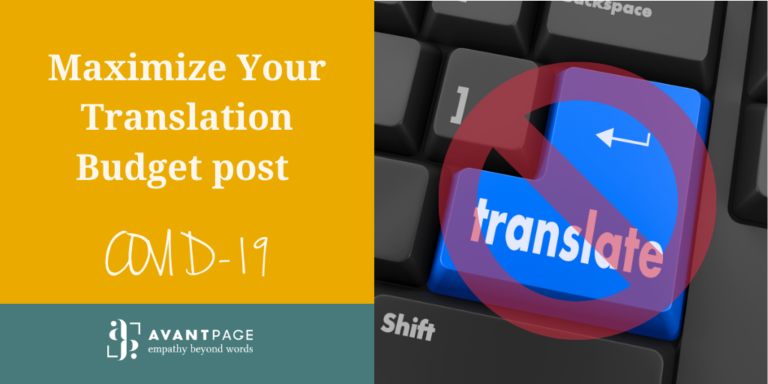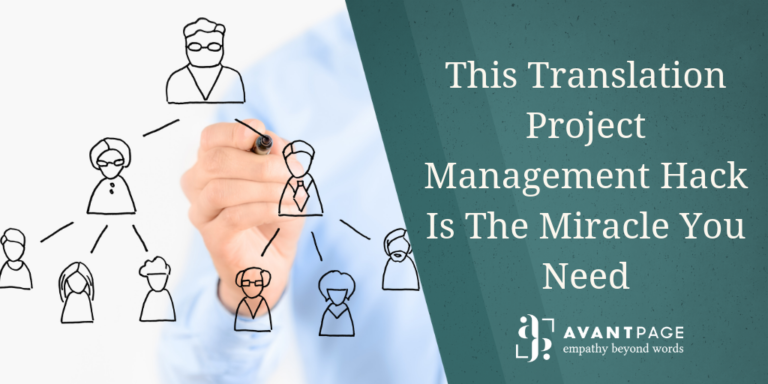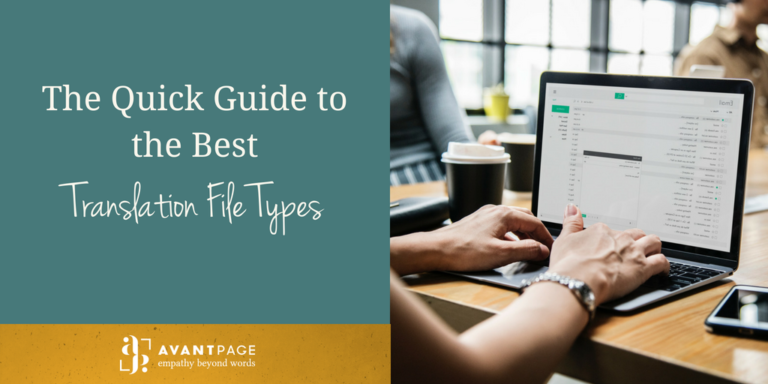Blogs

Maximize Your Translation Budget post COVID-19
COVID-19 continues to impact communities across the world. Both private and public sectors are forced to make significant budget revisions in response to recent drops in revenue and the changing needs of the people they serve. Having a limited budget doesn’t mean you can’t communicate effectively with immigrant and LEP communities. Many organizations may be tempted to turn to machine translation due to budget cuts, which may compromise the quality of their translation projects. In our blog dated Jan 9, 2020, we highlighted “The Many Ways Human Translation Benefits Your Organization”. Through our research, we came across with a study “Analysis of human versus machine translation accuracy” completed by Montana Technological University, Butte (Montana Tech) After many procedures and analysis, Montana Tech concluded: “Machine Translation (MT) is a fast way to obtain a domain-specific translation but is not recommended for literary translation… Based on the results of this study it is clear that human translators, with at least a moderate exposure to a non-native language, are more accurate than translation carried out using freely available MT tools… In the long run, mistranslation produced by machines could continue to be culturally offensive; cause harm in high-risk situations; and negatively affect a company’s brand, reputation, and revenues. The results of this research strongly indicate that international companies should adopt human translation resources as opposed to relying on cheaper, but considerably less effective and less accurate MT. Additionally, it is recommended that companies employ team translation where more than one person is involved in the translation process, which would further increase the accuracy of translation as a result of involving multiple individuals with variable interpretations of linguistic connotation and cultural meaning.” What are the alternatives? Whether you’re working on a large or small project, know your milestones and deadlines. Leverage translation best practices with your LSP. Identify your needs and define your scope Knowing your immediate and future language needs helps your LSP to make necessary accommodations and facilitates planning. It’s of benefit to your organization and your project to determine which content will best reach your target audience. If you don’t know where to start, you can work with your Language Service Provider to help make that determination. Gather your brand assets for design purposes Before starting your project, gather your logo, stock photos, downloads, and any other content that you’ll want to be used for the project. If you have the native, editable files (from InDesign, Photoshop, Illustrator, etc.), those are among the most useful assets to give to your LSP. Make use of linguistic assets Translation Memory reuses past translations to increase translation efficiency. When your translation project is completed, the language from the original (or source) document is stored along with the language from its translated counterpart in a secure database. This occurs with every project as you begin to build a translation memory. Glossaries, another linguistic asset, include a set of key terms and their approved translations. They’re particularly useful for indicating approved translations of industry-specific terms, and terms you want consistently translated across your documents. Style guides, the third of these vital tools, inform your LSP and translators about your organization’s look, voice, and general identity. This is also a great place to address practical questions for your translators, such as how to handle translating acronyms and what words should be left in English. Translation style guides and glossaries are some of the most critical components of your project. They will positively help to increase the consistency of your translated terms across all your material. Keep open communication with your LSP Your needs may change over time: you may need your LSP to add their Desktop Publishing process, a new language, or even a new language service. Be sure to communicate your plans, initiatives, and vision effectively to your LSP. At Avantpage, we create a culture of warmth, belonging, and approach every partnership with Empathy Beyond Words. Working on your translation projects during and after a pandemic such as COVID-19 needn’t be stressful. Thousands of customers trust us for our language services expertise combined with decades of experience. We have the courage to shape a better future for you and the immigrant communities you serve. Call us at 530-750-2040 or request a free quote today.
How COVID-19 shapes the Election
Exercising our civic duty to vote could become challenging during the COVID-19 pandemic. What can we expect for the next election? While there is uncertainty around how states will prepare for it, a move towards increased vote-by-mail seems inevitable. Western states’ residents have long participated in their elections from afar. Before COVID-19 pandemic Washington, Oregon, Utah, Colorado already led in vote-by-mail. States that already mastered massive vote-by-mail systems are serving as informal information clearinghouses for others, dispensing advice on everything from how to line up the best vendors for printing and distributing paper ballots to setting up drive-by or other drop-off points for voters. However, for states that don’t have a history of vote-by-mail, it's not an easy endeavor. The logistics of transitioning to vote-by-mail is a big undertaking and they have to take into consideration everyone, including their Limited English Proficient (LEP) communities. Are all registered voters going to receive a vote-by-mail ballot? On May 8, California Governor Gavin Newsom announced that his state will mail a ballot to all registered voters for the November general election. This is a significant decision as California and many states seek to protect both voting rights and public health during the COVID-19 pandemic. As mentioned above, Colorado, Hawaii, Oregon, Washington, and Utah already mail out ballots to all registered voters. For all other states that have not taken this initiative, registered voters must apply to vote by mail. What type of challenges could states face when deploying vote-by-mail? The CARES Act, passed in late March, included $400 million to help states run elections during the pandemic, but some states have raised concerns that they may not be able to access the funds because of restrictions. To address the restriction concerns, $4 billion has been identified to be set aside for voting by mail upon approval by lawmakers as the fourth COVID-19 stimulus package. Funding is not the only challenge. In New York City, the Board of Elections will begin mailing 3.6 million absentee ballot applications to voters, but with the national envelope shortage and requirement to provide prepaid postage so voters can return their ballot for free, there are real challenges for everyone. Additionally, there are myriad additional risks and hazards that could affect the elections such as power outages, wildfires, cyber-attacks, and even regular influenza that may occur at the same time. Are the risks greater for states’ LEP communities? While it is difficult to predict, there are legitimate feelings of fear and risks that there won’t be enough resources to care for all aspects concerning LEP communities. Translating outreach materials into all languages won’t be feasible. State and County officials will have to focus on the highest demand - from one county to another, the needs in translation could look very different. Unfortunately, some languages won’t make the cut as officials will have to prioritize due to their tight budgets. What will happen to poll workers (bilingual or other)? Even with increased vote-by-mail options, it is likely that many states will see some kind of in-person voting. Poll workers are essential, but are they putting themselves at risk? And in the lead up to the election, what will happen to their scheduled in-person training? In the event that a poll worker becomes ill due to the COVID-19 virus during training, for example, the entire team may have to be quarantined, leaving a staffing shortage. Poll worker understanding of language access rights on Election Day is essential, and this topic is just one part of the critical in-person training that counties carry out each cycle. There are concerns that online training may not be sufficient as a substitution. For states and counties where vote-by-mail ballot use is already high, the financial impact will be less significant than for those with low historical vote-by-mail numbers. Montana for example, with 63% historical vote-by-mail, will not see costs as high as North Dakota, where only 29% of voters voted by mail in 2018. Another consideration is the use of facsimile ballots in polling stations. We talked to one of our CA county partners, who laminates facsimile (sample) ballots for voters to take to the booth for comparison. While this solution may work for in-person voting, to provide this for an absentee ballot would mean printing and mailing the facsimile as well. This comes with additional cost, but also a huge risk that a voter might fill out the wrong version, and so additional measures must be taken to lower this risk. To assist states with the upcoming election, the U.S. Election Assistance Commission regularly updates its website with new election management resources. States planning to mail a ballot to all registered voters for the November general election may find this Vote By Mail Project Timeline useful. At Avantpage, we take tremendous pride in meeting your translation needs with outstanding service, quality, and Empathy Beyond Words. We currently partner with counties and states across the nation to provide election translation solutions. Contact us today to find out how we can help you too!

Technology to better serve our customers - How Avantpage bootstraps its data science strategy
Data science is the process of using algorithms, methods, and systems to extract knowledge and insights from data. In simple words, it means that executives and professionals use data and analytics to make predictions, to enhance optimization, and to improve operations and decision making. As it is constantly growing, it enables businesses to become more data-driven with better insights and knowledge. Like many organizations, Avantpage’s primary mission is to serve its customers. But at Avantpage, we go beyond the level of expectations of our customers. We vowed ourselves to help immigrant and LEP communities achieve their American Dream through translation services. With Empathy Beyond Words, we deliver the best translation and localization services to our partners and their end-users, while ensuring the happiness of our employees and providers through growth and opportunity. How do we do it? We leverage what we know... Faster. Better and More… with the end goal of being productive, obviously! Our success is no longer measured exclusively by how fast we can deliver error-free translations of high volume correspondence and other written materials. Nowadays, it depends on a holistic partnership with our clients. They want better organization and tracking of their projects, simple yet robust CRM tools, and a friction-free connectivity between them. Having visibility in what matters to our customers gives us an opportunity to improve the way we deliver our services. Everything our partners do leaves a data trail. This information is then used to optimize processes to increase the overall efficiency of our business. Why does it matter? We believe data is the currency of the future. Harnessing data enables us to craft proactive solutions of value, to stay relevant and aligned with our customers, to maximize our cross-functional team’s time and to have intelligible insights, better planning, and forecasting. Like many organizations operating in today’s metrics-driven environment, data is key to justify a business case or to validate the need for a change. But what type of data is the most critical to gather? For us and for many LSPs, the relevance of the data depends on the questions requiring answers. What are we trying to learn from it? Data enables us to gain visibility to the unknown. By soliciting and capturing the right information through the use of online forms or customer portals, we are able to anticipate the workload, the type of project requests, the language distribution before engaging in a conversation with our prospects and clients. We reduce risks by systematically tracking our on-time delivery records. Our teams consistently strive to increase efficiency gains through better and more effective processes, leveraging translation memory best practices to shorten delivery cycles and increase quality. Supporting the compliance needs of our clients, listening to how they want to see their data being reported, and ensuring their files and projects are managed according to their regulatory guidelines, helps us to build stronger partnerships. Such information helps us to be relevant, to communicate effectively to our partners and to help them with their immediate and future needs. It also provides us with insights into relationships that can be used to improve our business decision making. It transforms the way we do business and drives innovation. We needed a solid foundation, infrastructure, and processes to utilize the data we garnered, so we created AvantData. It was developed and implemented internally based on the cost-effective but highly skilled talents of our Systems Team. Our leadership team is invested and committed to its success, and the members have been instrumental in its inception and on-going development. Our first applications focused on creating dashboards for internal information, workflows for project optimization, and a portal to service our customers. Efficiency, productivity, and sense of urgency are some of our outstanding strengths and we were able to optimize them by leveraging AvantData. For example, thanks to the data, we were able to systematize our projects with optimized workflows. Our system is prompted every 10 minutes, it triggers the creation of a new workflow, automatically builds a project, retrieves respective files and notifies the relevant teams. Our teams leverage AvantData’s insights for decision making and planning. We focus on areas that add the most value for our customers as well as for our business. Thanks to the data, our teams are able to perform targeted Marketing activities, effective account optimization, as well as outstanding proactive account planning and growth. Using data to understand trends at the client level allows us to foresee peaks in project requests and scale accordingly. AvantData also empowers our employee career paths and opportunities. Finally it helps to organize our data for a future AI implementation roadmap. Gathering and managing data is essential for our productivity, customer relevance, and sales effectiveness. A data science strategy requires resources, expertise, and financial investment but it is essential for a company of any size. Whether it’s a startup, SMB, or an established corporation, it will help to serve customers faster and better while keeping employees happy and productive. We find that people, processes, and technology can be combined powerfully, even within a small structure like ours. Interested in finding out how we implemented our data science strategy? Register to watch Luis Miguel and Jessica Rathke's free webinar.

Do You Need To Hire A Translator?
There are many times when your business will need to hire a translator. The most obvious situation is when some specific laws or regulations require translation. In this situation, a professional translator is vital to ensuring the accuracy of your translation. However, hiring a professional translator can also help you reach new audiences, grow your business and make your life easier. Here are three ways the decision to hire a translator is the right one. When you hire a professional translator from a Language Services Provider (LSP) such as Avantpage, you get more than just one person—you get an entire team of people dedicated to making your life easier. From the project manager to the account manager to the linguist to the proofer, each person on your translation team is focused on ensuring the quality of your translation at each step of the process. Sometimes organizations try to save money by asking bilingual employees to help translate various documents. However, this decision can cost you time and money in various ways. When you hire a translator through an LSP, you can be confident that you are working with a professional who values accuracy. At Avantpage, we consider more than 40 pieces of information to ensure you get a high-quality translation that serves you and your consumers. Expanding language access to new audiences and customers can help you grow your business. For example, did you know that translation can help Limited English Proficiency (LEP) homebuyers overcome barriers to homeownership? In addition, translation of internal documents can help engage your LEP employees and boost productivity and results. If you hire a translator, you can translate the necessary documents to see business growth in multiple ways. When you hire a translator, you protect your organization’s credibility and its future. For more information about working with our high-quality translators, give us a call at 530-750-2040 or request a free quote today.

Federal voting regulations are determined to increase voting accessibility for those with limited English proficiency. Support them through translation.
Parents and families of all language backgrounds can positively impact their children’s education, and this is equally true for limited English proficient (LEP) parent engagement. However, relative to English-speaking parents, LEP parents have lower rates of attendance at general school meetings, parent-teacher conferences, or school or class events and lower rates of volunteering or serving on a committee, according to the National Household Education Surveys. To promote LEP parent engagement at your school, help these families see themselves as active participants in their student's learning. When a student’s parents or guardians become involved in his or her education, the student can see important benefits. Parent engagement can improve a student's academic achievement, behavior, attendance, social skills, and mental health. For LEP parents, engagement in their children's education can provide an excellent introduction to American society and increase their awareness of other community services available to them. There are many ways parents or guardians can become engaged with their student's education, including: For LEP parents and families, parent engagement in the school process can be a new cultural concept. Attempts to foster LEP parent engagement can often be interpreted as a call for interference. Many LEP parents believe that the school has the qualifications and responsibility to educate their children, and that parent engagement can be counter-productive. As a result, it's essential to explain the benefit of parent involvement to LEP parents. One of the most critical steps to cultivating LEP parent engagement is to eliminate barriers to involvement and provide an inclusive, collaborative environment. To remove barriers to LEP parent engagement, offer bilingual community liaisons to bridge language and cultural differences. The bilingual community liaison should be a highly respected member of the parents' language community who is knowledgeable about the American school system. Another way to facilitate LEP parent engagement is to use a good translation process. When LEP parents and guardians are provided with documentation they understand and connect with, they're more likely to get involved with their student's education. By increasing LEP parent engagement, you can help students improve their academic achievement and become more motivated students. If you don't have a translation process that creates meaningful access for LEP parents and guardians, call us today at (530) 750-2040 or request a free quote. We can help you increase LEP parent engagement in your school or district.

Translating Protected Health Information: What You Need To Know
Translating protected health information may be top of mind for you if you work for a healthcare or health insurance organization. Most of all, you may wonder how your Language Service Provider is translating protected health information (PHI) while following the appropriate regulations and ensuring confidentiality. The security of your patients' or clients' protected health information should be a high concern for you and your LSP. At Avantpage, we follow best practices when translating protected health information by using many processes and technologies. The Health Insurance Portability and Accountability Act (HIPAA) prohibits the unauthorized sharing of medical records and personally identifiable information without patient consent. This protected health information is often shared during the delivery of translation services and should be handled carefully by vendors for a covered health care entity. Because they are not employed by the organization using their services, translators are considered business associates under HIPAA legislation. Patient information should only be shared with a business associate for a specific purpose as stated in a business contract between a provider and hospital or clinic. To fully comply with HIPAA regulations, your LSP should incorporate the following: The most important step your organization can take when translating protected health information is to hire a professional translation company with experience in the healthcare field. Make sure to assess potential vendors carefully and continually monitor their adherence to the laws. Protected Health Information is essential, and your LSP should treat it that way. If you'd like to learn more about our data safety protocols at Avantpage, give us a call at 530-750-2040, or request a free quote.

This Translation Project Management Hack Is The Miracle You Need
Solid translation project management is the key to keeping the process running as smoothly and stress-free as possible. However, many people are involved in your translation project, including those in your organization and the individuals with your Language Services Provider. All those people can result in the proverbial problem of too many cooks in the kitchen. So, how can you clearly define everyone’s responsibilities to keep your translation project management on track? We’d suggest at RACI chart. A RACI chart, also known as a responsibility assignment matrix or a linear responsibility chart, defines the various roles needed for completing task or deliverables for a project. It is a handy tool for clarifying roles and responsibilities in cross-functional and departmental projects and processes. RACI is an acronym that stands for the following: For translation project management, a RACI chart can help every person involved understand what their role is and the expectations that go along with it. Each of the words and letters in RACI refers to a person's responsibility and role in the project. Here's a further definition of each one and examples of how it might apply to your translation project management: A RACI chart can help with translation project management by clearly defining the roles of every person involved. According to a Gallup study, employees who have clear priorities at work are more likely to be engaged and achieve better results. Before you begin your next translation project, download our free translation project RACI chart template and fill it out based on your organization. Consider all the people who may be involved and what roles they will play. Then, introduce the RACI chart at the beginning of your translation project and show each person the part they are expected to play. By clearly laying out expectations and involved at the beginning of your translation project management, you are more likely to have better results and a less stressful process. Effective translation project management is one of the many benefits of working with Avantpage. If you want to learn more about how we can work together to streamline your translation projects, give us a call at 530-750-2040, or request a free quote.

Here Are The Players Who Make Up Your Translation Team
Your translation team is more than just a translator or linguist who is working diligently to translate your content and documents. In fact, many people work together behind the scenes to ensure the quality of your translation at each step of the process. Here are some key roles a capable translation team will have. On a day-to-day basis, the project manager is whom you'll work with the most on your translation team. This person is intricately involved in all the details of your project, from understanding the content to spotting confidentiality issues to selecting the best translators and designers for the job. Your account manager gets involved when your needs go beyond an existing translation project. For example, if you want a different service that’s not in your contract, your AM will be the person who asks some questions about your needs to develop pricing. Your AM can also work in tandem with your PM to help resolve specific problems. Every project is a bit different when it comes to geography, field, and language, and finding the right linguists who fit those specifications is essential. To find the right fit for your translation team, your PM should match qualified translators with your specific project's needs and languages to ensure success. The proofer is the quality control person on your translation team. This person focuses on the last step of the translation project and ensures the quality of the translation, the layout, and any non-linguistic requirements. These people focus on details and understand how to work with style guides and specifications. Depending on the complexity of your project, your translation team may also include designers and other professionals who can help steer your project to success. For almost every project, a capable and talented translation team can make all the difference. At Avantpage our experienced translation team can help guide you through the translation process and make it fast and easy. To find out more about our services or to get a free quote, Email us at [email protected] or call us at 1-530-750-2040, extension 6.

How Translation Can Help LEP Homebuyers Overcome Barriers
LEP homebuyers face increased barriers to homeownership, and many of those barriers are related to language access. According to a study by the Urban Institute, there is a 5 to 10 percentage-point gap in homeownership rates between neighborhoods with low levels of Limited English Proficient residents and those with higher levels of LEP residents. The Urban Institute studied data at the zip code level from the Urban Institute and Sloan Foundation’s Administrative Data Research Facility and found that neighborhoods with the lowest concentration of LEP residents had a median homeownership rate of 74 percent in 2016. However, communities with the highest LEP concentration had only a 64 percent median rate—a 10 percentage-point difference. Even when other factors such as income, age, and race are considered and controlled, neighborhoods with the highest concentrations of LEP residents still have homeownership rates 5 percentage points lower than rates in neighborhoods with the median concentration of LEP residents. This may be because of how vital language access is to be obtaining a mortgage. In a 2017 study conducted by Fannie Mae and Freddie Mac, an independent firm researched the attitudes and experiences of LEP homebuyers. The researchers talked with Chinese (Mandarin), Korean, Spanish, Tagalog, and Vietnamese LEP homebuyers in New York, Maryland, and Texas. Overall, the study found that LEP homebuyers in all those locations and languages want easily accessible translated documents as they navigate the home buying process. The LEP homebuyers surveyed reported a range of potential benefits when using in-language documents. According to the study, these translated documents can: While LEP homebuyers said they would value translated documents, they also had several concerns about poorly translated documents. In the worst of cases, these mistranslated documents can decrease trust and increase cultural tensions. As a result, translations for LEP homebuyers must be rigorously tested to ensure they work for the intended audience and purpose. Translations must include an active and in-depth interpretation of the concepts and cultural expectations to achieve true understanding. They must also be viewed through the lens of LEP homebuyers who are unfamiliar with the process. When you work with a professional language services provider, such as Avantpage, you can be sure that a team of language experts is working together to translate your documents for LEP homebuyers in a clear way. For more information on how to support LEP homebuyers through translation, call us today at (530) 750-2040, or request a free quote.

6 Funny False Cognates That Have A Double Meaning
Here’s a false cognates pop quiz: If you say “Estoy embarazada,” are you telling someone that you’re embarrassed, or that you’re pregnant? How about your Portuguese friend tells you “Me peidei!” Is this person telling you it’s payday! Or that you may want to move to another part of the room since he or she has just passed gas? If you chose “pregnant” and “passed gas,” then you’ve identified the perils of false cognates. False cognates are pairs of words that sound or look the same (sometimes even identical) but have very different meanings. Linguists will sometimes call these words False Friends, which comes from the longer phrase “false friends of the translator” coined in 1928 by two French linguists. These words are also sometimes called deceptive words, treacherous twins or belles infidèles (unfaithful beautiful women). The term “false friends” is actually a broader category that includes false cognates, and refers to any pair of lookalike words from two languages that don’t have the same definition. The short answer to this question is that it shouldn’t if you’re using a professional Language Services Provider (such as Avantpage). A professional translator would usually not make a fundamental mistake such as confusing false cognates. When our translators adhere to important guidelines that guarantee high-quality translation, they always keep in mind the audience of the document. As a result, our translators and editors always consider your end-users and what false cognates may pertain to them. That being said, false cognates are sometimes very humorous! Here are some of our favorite examples of tricky false cognates. Those are just a few examples of some false cognates that can cause some confusion. But, if you’re using a professional Language Services Provider, you won’t have to worry about a thing.

The Quick Guide to the Best Translation File Types
At Avantpage, we can translate documents into more than 150 languages, but that work is a lot easier if we receive one of our preferred translation file types. What's a preferred translation file type? Simply put, it's an editable document that we can place a cursor in and click around and delete or add words. When we work with these translation file types, our team can work faster because they don’t have to recreate the document. Here’s a quick guide to some of the common translation file types we receive and how they affect our workflow. Text files are usually created in a program such as Microsoft Word, Google Docs, Pages, Notepad or TextEdit. Presentations created in PowerPoint or spreadsheets created in Excel would also fall into this category. These files are generally pretty easy to use for translation. It’s especially important to send us the original file of your document if it includes images or complicated charts, as this will allow us to edit the element directly. One quick note though—exporting or copy and pasting a PDF file back into a text document can often introduce errors or formatting issues that may require recreation. Graphics files are well, graphical! These translation file types include a photo with text on it, a chart, an illustration, a flyer, a multi-page pamphlet or even a book. The most important thing to know about these types of files is that sending an editable one for translation will not require recreation. For example, if you send an Adobe Indesign (.indd, .imdl), Adobe Illustrator (.ai) or Adobe Photoshop document (.psd), we can edit that file directly and create your translation. However, if you send a file that's "frozen" such as a picture (.jpg, .gif, .png, or .tif) or PDF (.pdf), our team at Avantpage will not be able to edit the document and will need to recreate it. While recreation can be an additional expense, the beauty of having it recreated is that you can update the document or translate it into another language very easily. If you need to translate an entire website, a series of blog posts or another type of web-based content, you may think that you need to copy and paste all of it into an editable text document. However, we have an easier way! At Avantpage, we can work on the backend of a website directly in the code. This can ensure additional accuracy and clarity for your project. While some of this language and acronyms can be very technical and specific, sending easy to work with translation file types ensures that your project can be done quickly and within budget. Translation File Types Checklist At Avantpage our experienced team can help guide you through the translation process and make it fast and easy—no matter the file type. To find out more about our services or to get a free quote, email us at [email protected] or call us at 1-530-750-2040, extension 11.

How Improved Language Access Can Make Healthcare Better
About 20 percent of the United States population speaks a language other than English at home, and almost 9 percent of the population is defined as having Limited English Proficiency. And almost 100 percent of these people must interact with healthcare providers and insurers either in emergency situations or for routine care. For LEP individuals, language access is a critical part of accessing healthcare. A lack of language access can create barriers for LEP patients and their families, putting them at risk for complications and unnecessary expenses. Language access can also help or hurt a provider, hospital, or insurance's ability to provide the right care or coverage. Here are the many ways that limited language access can affect patients, healthcare providers, and insurance. LEP patients are almost twice as likely to suffer adverse events in U.S. hospitals, resulting in temporary harm or death, according to a pilot study by The Joint Commission. Another study reported that 52 percent of adverse events that occurred to LEP patients in U.S. hospitals were likely the result of communication errors and that nearly half of these events involved some physical harm. Lack of language services can cause increased use of expensive diagnostic tests, increased number and duration of emergency room visits, and a higher likelihood of intubation for children with asthma. Language barriers affect patient satisfaction and whether or not patients will return to a particular healthcare institution. Providers can also become frustrated with limited language access in a healthcare setting when they want to serve all patients equally and to the best of their abilities. Patients who face language barriers are less likely to have a usual source of medical care and to receive preventive services. They also have an increased risk of nonadherence to medication. In a Colorado study, LEP patients reported difficulty making appointments, including multiple phone transfers and frequent disconnections. The lack of qualified interpreters made them fearful of accessing care and prevented them from seeking the treatment they needed. Patients also said it was difficult to get accurate and timely information related to medication and access preventive care. Conversely, when LEP individuals receive language access resources in a healthcare setting, their quality of care and satisfaction increase. For example: When LEP patients receive medical language services, hospitals experience an increase in LEP patient engagement, an enhancement in LEP patient-provider communication, and improvements in LEP patient outcome. Patients who receive clear and concise information about their healthcare and well-being tend to be more actively engaged in their care plans, resulting in shorter lengths of stay and lower readmissions. The use of a qualified medical interpreter can lessen the length of an LEP patient's stay by almost a day, according to a study by the Department of Family Medicine and Community Health & Division of Preventive and Behavioral Medicine at the University of Massachusetts Medical School. Shorter stay lengths can improve LEP patient outcomes and significantly lower the cost of patient care for health systems. As a healthcare provider or insurance company, offering language access services that address the needs of LEP patients can increase access and quality of care while decreasing time, expense, and adverse events. At Avantpage, we can help your healthcare organization reach LEP populations and expand language access. To find out more about our services call us at 530-750-2040 x11, or request a free quote.